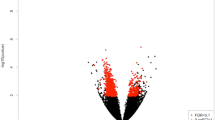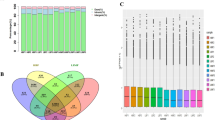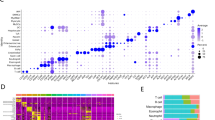Abstract
Pork is of great importance in world trade and represents the largest source of fatty acids in the human diet. Lipid sources such as soybean oil (SOY), canola (CO), and fish oil (FO) are used in pig diets and influence blood parameters and the ratio of deposited fatty acids. In this study, the main objective was to evaluate changes in gene expression in porcine skeletal muscle tissue resulting from the dietary oil sources and to identify metabolic pathways and biological process networks through RNA-Seq. The addition of FO in the diet of pigs led to intramuscular lipid with a higher FA profile composition of C20:5 n-3, C22:6 n-3, and SFA (C16:0 and C18:0). Blood parameters for the FO group showed lower cholesterol and HDL content compared with CO and SOY groups. Skeletal muscle transcriptome analyses revealed 65 differentially expressed genes (DEG, FDR 10%) between CO vs SOY, and 32 DEG for CO vs FO, and 531 DEG for SOY vs FO comparison. Several genes, including AZGP1, PDE3B, APOE, PLIN1, and LIPS, were found to be down-regulated in the diet of the SOY group compared to the FO group. The enrichment analysis revealed DEG involved in lipid metabolism, metabolic diseases, and inflammation between the oil groups, with specific gene functions in each group and altered blood parameters. The results provide mechanisms to help us understand the behavior of genes according to fatty acids.










Similar content being viewed by others
Data availability
The dataset supporting the conclusions of this article is available in the in the European Nucleotide Archive (ENA) repository (EMBL-EBI), under accession PRJEB52629 [http://www.ebi.ac.uk/ena/data/view/PRJEB52629]. The original contributions presented in the study are included in the article/”Supplementary information”; further inquiries can be directed to the corresponding author.
References
Alexandraki K, Piperi C, Kalofoutis C et al (2006) Inflammatory process in type 2 diabetes: the role of cytokines. In: Annals of the New York Academy of Sciences
Almeida VV, Silva JPM, Schinckel AP et al (2021) Effects of increasing dietary oil inclusion from different sources on growth performance, carcass and meat quality traits, and fatty acid profile in genetically lean immunocastrated male pigs Livest Sci 248 104515 https://doi.org/10.1016/J.LIVSCI.2021.104515
Bazewicz CG, Dinavahi SS, Schell TD, Robertson GP (2019) Aldehyde dehydrogenase in regulatory T-cell development, immunity and cancer. Immunology 156
Benjamini Y, Hochberg Y (1995) Controlling the false discovery rate: a practical and powerful approach to multiple testing J R Stat SocSer B 57. https://doi.org/10.1111/j.2517-6161.1995.tb02031.x
Benz JM, Tokach MD, Dritz SS et al (2011) Effects of choice white grease and soybean oil on growth performance, carcass characteristics, and carcass fat quality of growing-finishing pigs J AnimSci 89 https://doi.org/10.2527/jas.2009-2737
Burnett DD, Legako JF, Phelps KJ, Gonzalez JM (2020) Biology, strategies, and fresh meat consequences of manipulating the fatty acid composition of meat. J. Anim. Sci. 98
Cesar ASM, Regitano LCA, Poleti MD et al 2016 Differences in the skeletal muscle transcriptome profile associated with extreme values of fatty acids content BMC Genomics 1–16 https://doi.org/10.1186/s12864-016-3306-x
Chakrabarti SK, Wen Y, Dobrian AD et al (2011) Evidence for activation of inflammatory lipoxygenase pathways in visceral adipose tissue of obese Zucker rats Am J Physiol - EndocrinolMetab 300 https://doi.org/10.1152/ajpendo.00203.2010
Chin CH, Chen SH, Wu HH et al (2014) cytoHubba: Identifying hub objects and sub-networks from complex interactome BMC Syst Biol 8 https://doi.org/10.1186/1752-0509-8-S4-S11
Chu A, Najafzadeh P, Sullivan P et al (2019) Aldehyde dehydrogenase isoforms and inflammatory cell populations are differentially expressed in term human placentas affected by intrauterine growth restriction Placenta 81 https://doi.org/10.1016/j.placenta.2019.03.015
Clarivate analytics (2022) MetaCore and Cortellis solution [Internet]
Corominas J, Ramayo-Caldas Y, Puig-Oliveras A et al (2013) Analysis of porcine adipose tissue transcriptome reveals differences in de novo fatty acid synthesis in pigs with divergent muscle fatty acid composition BMC Genomics 14 https://doi.org/10.1186/1471-2164-14-843
Curtis JM, Grimsrud PA, Wright WS et al (2010) Downregulation of adipose glutathione S-tansferase A4 leads to increased protein carbonylation, oxidative stress, and mitochondrial dysfunction Diabetes 59 https://doi.org/10.2337/db09-1105
Dobin A, Gingeras TR (2015) Mapping RNA-seq Reads with STAR CurrProtoc Bioinforma 51 https://doi.org/10.1002/0471250953.bi1114s51
Duan Y, Li F, Li L et al (2014) N-6:n-3 PUFA ratio is involved in regulating lipid metabolism and inflammation in pigs Br J Nutr 111 https://doi.org/10.1017/S0007114513002584
Fanalli SL, Silva da BPM, Petry B et al (2022a) Dietary fatty acids applied to pig production and their relation to the biological processes: A review Livest Sci 265 105092 https://doi.org/10.1016/J.LIVSCI.2022.105092
Fanalli SL, Fanalli BPM, Silva da JD, Gomes et al (2022b) Effect of dietary soybean oil inclusion on liver-related transcription factors in a pig model for metabolic diseases Sci Rep 12 https://doi.org/10.1038/s41598-022-14069-1
Fanalli SL, Silva da BPM, Gomes JD (2022c) Differential gene expression associated with soybean oil level in the diet of pigs Anim Vol 12 Page 1632 12 1632 https://doi.org/10.3390/ANI12131632
Fang B, Ren X, Wang Y et al (2018) Apolipoprotein E deficiency accelerates atherosclerosis development in miniature pigs DMM Dis Model Mech 11 https://doi.org/10.1242/dmm.036632
Fass (2010) Guide for the care and use of agricultural animals in research and teaching, 3rd edn. Federation of Animal Science Societies, Champaign, IL
Frayn KN, Arner P, Yki-Järvinen H (2006) Fatty acid metabolism in adipose tissue, muscle and liver in health and disease Essays Biochem 42 https://doi.org/10.1042/bse0420089
Galli A, Price D, Crabb D (1999) High-level expression of rat class I alcohol dehydrogenase sis sufficient for ethanol-induced fat accumulation in transduced HeLa cells Hepatology 29 https://doi.org/10.1002/hep.510290420
Gandolfi G, Mazzoni M, Zambonelli P et al (2011) Perilipin 1 and perilipin 2 protein localization and gene expression study in skeletal muscles of European cross-breed pigs with different intramuscular fat contents Meat Sci 88 https://doi.org/10.1016/j.meatsci.2011.02.020
Ghobadi S, Hassanzadeh-Rostami Z, Mohammadian F, et al (2019) Effects of canola oil consumption on lipid profile: a systematic review and meta-analysis of randomized controlled clinical trials. J. Am. Coll. Nutr. 38
Gomes JD, Costa KA, Almeida VV de, et al (2021) Effects of dietary oil inclusion on meat quality of immunocastrated male pigs. Rev Bras Agrotecnologia 11: https://doi.org/10.18378/rebagro.v12i2.8802
Gornall AG, Bardawill CJ, David MM (1949) Determination of serum proteins by means of the biuret reaction J Biol Chem 177 https://doi.org/10.1016/s0021-9258(18)57021-6
Grimsrud PA, Picklo MJ, Griffin TJ, Bernlohr DA (2007) Carbonylation of adipose proteins in obesity and insulin resistance: identification of adipocyte fatty acid-binding protein as a cellular target of 4-hydroxynonenal Mol Cell Proteomics 6 https://doi.org/10.1074/mcp.M600120-MCP200
Hevener AL, He W, Barak Y et al (2003) Muscle-specific Pparg deletion causes insulin resistance Nat Med 9 https://doi.org/10.1038/nm956
Jeromson S, Gallagher IJ, Galloway SDR, Lee DHamilton (2015) marine drugs omega-3 fatty acids and skeletal muscle health. Mar Drugs 13:6977–7004. https://doi.org/10.3390/md13116977
Kardassis D, Gafencu A, Zannis VI, Davalos A (2015) Regulation of HDL genes: transcriptional, posttranscriptional, and posttranslational. In: Handbook of Experimental Pharmacology
Kasprzyk A, Tyra M, Babicz M (2015) Fatty acid profile of pork from a local and a commercial breed Arch Tierzucht 58 10.5194/aab-58-379-2015
Lazar MA (2005) PPARγ, 10 years later. In: Biochimie
Li B, Weng Q, Dong C et al (2018) A key gene, PLIN1, can affect porcine intramuscular fat content based on transcriptome analysis Genes (Basel) 9 https://doi.org/10.3390/genes9040194
Lin L, Allemekinders H, Dansby A et al (2013) Evidence of health benefits of canola oil Nutr Rev 71 https://doi.org/10.1111/nure.12033
Love MI, Huber W, Anders S (2014) Moderated estimation of fold change and dispersion for RNA-seq data with DESeq2 Genome Biol 15 https://doi.org/10.1186/s13059-014-0550-8
Ma X, Jiang Z, Lai C (2016) Significance of increasing n-3 PUFA content in pork on human health. Crit Rev Food SciNutr 56 https://doi.org/10.1080/10408398.2013.850059
Martins JM, Albuquerque A, Neves JA et al (2018) Influence of outdoor rearing and oleic acid supplementation on lipid characteristics of muscle and adipose tissues from obese Alentejano pigs J AnimPhysiol Anim Nutr (Berl) 102 https://doi.org/10.1111/jpn.12799
Martins JM, Neves JA, Freitas A, Tirapicos JL (2015) Rearing system and oleic acid supplementation effect on carcass and lipid characteristics of two muscles from an obese pig breed Animal 9 https://doi.org/10.1017/S175173111500066X
Mitchaothai J, Yuangklang C, Wittayakun S et al (2007) Effect of dietary fat type on meat quality and fatty acid composition of various tissues in growing-finishing swine Meat Sci 76 https://doi.org/10.1016/j.meatsci.2006.10.017
Mothe-Satney I, Filloux C, Amghar H et al (2012) Adipocytes secrete leukotrienes: contribution to obesity-associated inflammation and insulin resistance in mice Diabetes 61 https://doi.org/10.2337/db11-1455
Mracek T Gao D Tzanavari T et al (2010) Downregulation of zinc-α2-glycoprotein in adipose tissue and liver of obese ob/ob mice and by tumour necrosis factor-α in adipocytes J Endocrinol 204 https://doi.org/10.1677/JOE-09-0299
Myer RO, Lamkey JW, Walker WR et al (1992) Performance and carcass characteristics of swine when fed diets containing canola oil and added copper to alter the unsaturated:saturated ratio of pork fat J AnimSci 70 https://doi.org/10.2527/1992.7051417x
Niroumand S, Khajedaluee M, Khadem-Rezaiyan M, et al (2015) Atherogenic index of plasma (AIP): a marker of cardiovascular disease. Med J Islam Repub Iran 29:
Pan Z, Pan Y, Yao H, Yin et al (2021) Pig genome functional annotation enhances the biological interpretation of complex traits and human disease Nat Commun 12 https://doi.org/10.1038/s41467-021-26153-7
Park CY, Han SN (2018) Lipid pathway in liver cells and its modulation by dietary extracts. In: The molecular nutrition of fats
Peñuela-Sierra L, Castañeda-Serrano R, Sanmiguel RA (2015) Ácidos graxos poliinsaturados e ácido linoléico conjugado na carne suína. Benefícios para a saúde humana: Revisão. PubVet 9 https://doi.org/10.22256/pubvet.v9n7.337-347
Piórkowska K, Małopolska M, Ropka-Molik K et al (2020) Evaluation of scd, acaca and fasn mutations: Effects on pork quality and other production traits in pigs selected based on rna-seq results Animals 10 https://doi.org/10.3390/ani10010123
Puig-Oliveras A, Ramayo-Caldas Y, Corominas J et al (2014) Differences in muscle transcriptome among pigs phenotypically extreme for fatty acid composition PLoS One 9 https://doi.org/10.1371/journal.pone.0099720
Ramayo-Caldas Y, Mach N, Esteve-Codina A et al (2012) Liver transcriptome profile in pigs with extreme phenotypes of intramuscular fatty acid composition BMC Genomics 13 https://doi.org/10.1186/1471-2164-13-547
Rostagno HS (2011) Tabelasbrasileiras para aves e suínos: composição de alimentos e exigências nutricionais Tabelas Bras Para Aves e Suínos Compos Aliment e Exig Nutr 2 186
Saedi S, Noroozi M, Khosrotabar N et al (2017) How canola and sunflower oils affect lipid profile and anthropometric parameters of participants with dyslipidemia. Med J Islam Repub Iran 31 https://doi.org/10.18869/mjiri.31.5
Saini RK, Keum YS (2018) Omega-3 and omega-6 polyunsaturated fatty acids: dietary sources, metabolism, and significance — A review. Life Sci. 203
Salgado J (2017) Ácidos Graxos Essenciais
Shannon P, Markiel A, Ozier O et al (2003) Cytoscape: a software environment for integrated models of biomolecular interaction networks Genome Res 13 https://doi.org/10.1101/gr.1239303
Shimizu N, Maruyama T Yoshikawa N et al (2015) A muscle-liver-fat signalling axis is essential for central control of adaptive adipose remodelling Nat Commun 6 https://doi.org/10.1038/ncomms7693
Song CH, Oh SM, Lee SH et al (2020) The ratio of dietary n-3 polyunsaturated fatty acids influences the fat composition and lipogenic enzyme activity in adipose tissue of growing pigs Food SciAnim Resour 40 https://doi.org/10.5851/kosfa.2020.e8
Stelzer G, Rosen N, Plaschkes I et al (2016) The GeneCards suite: from gene data mining to disease genome sequence analyses. Curr Protoc Bioinforma 2016: https://doi.org/10.1002/cpbi.5
Trinder P (1969) Determination of glucose in blood using glucose oxidase with an alternative oxygen acceptor Ann Clin Biochem Int J Lab Med 6 https://doi.org/10.1177/000456326900600108
Uddin MJ, Duy DN, Cinar MU et al (2011) Detection of quantitative trait loci affecting serum cholesterol, LDL, HDL, and triglyceride in pigs BMC Genet 12 https://doi.org/10.1186/1471-2156-12-62
Udhaya S, Kumar D, Thirumal Kumar PD, Mandal et al (2020) Comprehensive in silico screening and molecular dynamics studies of missense mutations in Sjogren-Larsson syndrome associated with the ALDH3A2 gene Adv Protein ChemStruct Biol 120 https://doi.org/10.1016/bs.apcsb.2019.11.004
Ulbricht TLV, Southgate DAT (1991) Coronary heart disease: seven dietary factors Lancet 338 https://doi.org/10.1016/0140-6736(91)91846-M
Unoki H, Bujo H, Yamagishi ichi S et al (2007) Advanced glycation end products attenuate cellular insulin sensitivity by increasing the generation of intracellular reactive oxygen species in adipocytes Diabetes Res ClinPract 76 https://doi.org/10.1016/j.diabres.2006.09.016
USDA (2022) Livestock and Poultry. In: UNITED STATES Dep. Agric. PDS ONLINE. https://apps.fas.usda.gov/psdonline/circulars/livestock_poultry.pdf
van der Velde AE (2010) Reverse cholesterol transport: from classical view to new insights. World J. Gastroenterol. 16
Wan M, Tang X, Stsiapanava A, Haeggström JZ (2017) Biosynthesis of leukotriene B4. Semin. Immunol. 33
Wang W, Xue W, Xu X, et al (2016) Correlations of genes expression in PPAR signalling pathway with porcine meat quality traits. Czech J Anim Sci 61: https://doi.org/10.17221/85/2015-CJAS
Welch JS, Ricote M, Akiyama TE et al (2003) PPARγ and PPARδ negatively regulate specific subsets of lipopolysaccharide and IFN-γ target genes in macrophages Proc Natl AcadSci U S A 100 https://doi.org/10.1073/pnas.1031789100
White R, Giordano S, Datta G (2017) Role of HDL-Associated Proteins and Lipids in the Regulation of Inflammation. In: Advances in Lipoprotein Research
Yu YH, Wu SC, Cheng WTK et al (2011) The function of porcine PPARγ and dietary fish oil effect on the expression of lipid and glucose metabolism related genes J Nutr Biochem 22 179 186 https://doi.org/10.1016/j.jnutbio.2010.01.006
Zhang HH, Halbleib M, Ahmad F et al (2002) Differentiated human adipocytes through activation of extracellular signal – related kinase and elevation of intracellular cAMP Diabetes 51 2929 2935
Zhang J, Xu X, Zhu H, et al (2019) Dietary fish oil supplementation alters liver gene expressions to protect against LPS-induced liver injury in weanling piglets Innate Immun 25 https://doi.org/10.1177/1753425918821420
Zhi HH, Luque RM, Kineman RD, Mazzone T (2007) Nutritional regulation of adipose tissue apolipoprotein E expression Am J Physiol - EndocrinolMetab 293 https://doi.org/10.1152/ajpendo.00118.2007
Acknowledgements
We thank the collaborative efforts between the University of São Paulo and Iowa State University. We also give thanks to DB Genética Suína for providing the animals, housing, feeds, and employees, who helped in carrying out this research.
Funding
This study was supported by the São Paulo Research Foundation (FAPESP, Grant numbers: 2020/10042–6, 2017/25180–2, 2018/15653–3, 2018/26797–6, 2018/26816–0, 2021/06553–8, and 2014/02493–7, the Brazilian National Council for Scientific and Technological Development (CNPq) that provided a researcher fellowship to A. S. M. Cesar, L. L. Coutinho. This study was financed in part by the Coordenação de Aperfeiçoamento de Pessoal de Nível Superior—Brasil (CAPES)—Finance Code 001.
Author information
Authors and Affiliations
Contributions
All authors contributed to this study. Conceptualization, S. L. F., G. C. M. M., J. M. R., J. E. K., D. K., H. F., L. C. A. R., J. C. d. C. B., L. L. C., and A. S. M. C.; writing (original draft preparation), S. L. F. J. D. G., B. P. M. d. S., and A. S. M. C.; performed data analysis, S. L. F., V. V. d. A., F. A. O. F., and A. S. M. C.; interpretation and discussion of the results, S. L. F., G. C. M. M., V. V. d. A., L. L. C., H. F., L. C. A. R., A. L. F., A. S. M. C.; critically reviewed and editing, V. V. d. A., B. S. V, J. A., G. C. M. M., J. M. R., J. E. K., D. K., D. G., H. F., L. C. A. R., G. B. M., L. L. C., M. D. P., S. M. d. A., A. L. F., and A. S. M. C.; supervision, A. S. M. C.; funding acquisition, A. S. M. C.
All authors have read and agreed to the published version of the manuscript.
Corresponding author
Ethics declarations
Ethics approval
All animal procedures were conducted in accordance with the Guide for the Care and Use of Agricultural Animals in Agricultural Research and Teaching and were approved by the Animal Care and Use Committee of Luiz de Queiroz College of Agriculture (University of São Paulo, Piracicaba, Brazil, protocol: 2018.5.1787.11.6 and number CEUA 2018–28).
Consent for publication
Not applicable.
Consent to participate
Not applicable.
Competing interests
The authors declare no competing interests.
Additional information
Publisher's note
Springer Nature remains neutral with regard to jurisdictional claims in published maps and institutional affiliations.
Supplementary Information
Below is the link to the electronic supplementary material.
Rights and permissions
Springer Nature or its licensor (e.g. a society or other partner) holds exclusive rights to this article under a publishing agreement with the author(s) or other rightsholder(s); author self-archiving of the accepted manuscript version of this article is solely governed by the terms of such publishing agreement and applicable law.
About this article
Cite this article
Fanalli, S.L., da Silva, B.P.M., Gomes, J.D. et al. Transcriptome profile of skeletal muscle using different sources of dietary fatty acids in male pigs. Funct Integr Genomics 23, 73 (2023). https://doi.org/10.1007/s10142-023-00997-2
Received:
Revised:
Accepted:
Published:
DOI: https://doi.org/10.1007/s10142-023-00997-2




